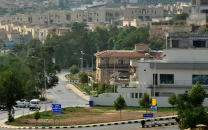Monsoon in the mountains
With breathtaking peaks and unpredictable floods, tourists must balance wonder with caution in G-B

Gilgit-Baltistan (GB), a land of towering peaks, lush valleys, and glacial rivers, has long captivated travellers seeking adventure and serenity, yet, behind its postcard beauty lies a recurring seasonal threat.
Monsoon rains and climate change-driven glacier outbursts frequently test the resilience of this region and its people. The challenge for authorities, locals, and tourists alike is clear: how to balance the call of adventure with the demands of safety.
The latest disaster struck Ghizer district on Wednesday night when a massive glacier burst unleashed catastrophic flooding. The Ghizer River was choked, villages were swept away, and a 7-km lake formed by a mountain mudslide.
The National Disaster Management Authority (NDMA) termed the blockage a "dam-like structure" that could burst at any moment, raising fears among the local of a catastrophic flood downstream.
The Ghizer tragedy is not an isolated incident. This summer alone, relentless flash floods have caused an estimated Rs30 billion in damages across G-B, killing at least 39 people, including tourists.
The Pakistan Meteorological Department (PMD) has already warned of another spell of heavy rainfall this week, with high-risk districts including Diamer, Astore, Ghizer, Skardu, Hunza, Gilgit, Ghanche, and Shigar.
For travellers, this means planning a trip during the monsoon comes with both breathtaking views and heightened danger.
For visitors, G-B is nothing short of a paradise. From snow-capped mountains and glacier-fed lakes to zigzagging roads through tall pines, the experience is unforgettable.
But as soon as the first raindrops hit the dry slopes, beauty and danger intertwine. Rain nourishes valleys and revives rivers, yet it also weakens mountainsides, triggering landslides that can block roads or isolate entire valleys.
The KKH - Pakistan's vital artery to China — often bears the brunt. Sections near Chilas, Raikot Bridge, and stretches between Sost and Gulmit are notorious for landslides.
Roads to Astore, Skardu, and Kaghan valleys may also collapse under floods. At times, communication networks shut down, leaving tourists stranded with no way to reach help. Authorities acknowledge the challenges but insist that measures are being taken.
The Gilgit-Baltistan Disaster Management Authority (GBDMA) reported that since 2022, more than 80 major landslides have blocked the KKH, affecting over 60,000 people.
"Tourists should check weather alerts and keep their plans flexible," advised a Hunza-based tour operator with 15 years of experience. "Carry medicines, snacks, and water. Most importantly, stay patient and avoid unnecessary risks."
She added that many operators now ensure visitors have local SIM cards and emergency numbers, while locals often assist in clearing blocked roads.
For tourists, preparation can be the difference between discomfort and disaster. Ahmed Raza from Lahore, who travelled to Skardu and Shigar in July 2023, recalled how his vehicle got stuck near Shigar Bridge.
"The locals were very helpful, but the real lifesaver was our guide, who had packed snacks and water. Without him, it would have been a nightmare."
Such experiences highlight the importance of hiring experienced local guides familiar with the terrain and emergency procedures. Guides often anticipate risks and know when to wait, reroute, or evacuate.
Beyond immediate rescue, long-term resilience is being strengthened. More weather stations and faster warning systems are being installed to provide timely alerts. Stronger roads, bridges, and tunnels — such as those at Attabad and Shounter — are reducing isolation risks.
Organisations like Focus Pakistan and the Aga Khan Agency for Habitat are training locals in first aid and emergency response. Tour companies increasingly offer insurance to cover travel delays.
Emergency services are also upgrading. Rescue 1122 is expanding its equipment, and inter-departmental coordination has improved. At airports, hotels, and bus stations, tourists are briefed on safety precautions.
Gilgit-Baltistan in the rainy season is both breathtaking and unpredictable. Waterfalls swell, the air turns fresh, and the landscapes are at their most vibrant. Yet, each journey requires mindfulness.
Safety cannot rest solely on government departments or local volunteers — tourists themselves must be proactive.
Checking weather alerts, keeping plans flexible, hiring local guides, carrying essentials, and respecting the power of nature are not just tips but survival tools. In a land where glaciers melt and rivers rage, every traveller must prepare for the unexpected.
(WITH INPUTS FROM APP)





















COMMENTS
Comments are moderated and generally will be posted if they are on-topic and not abusive.
For more information, please see our Comments FAQ